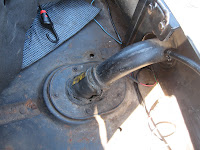Me and the boy

And here's one from a church fund-raiser we did yesterday. I designed the team shirts :)
Labels: Miscellaneous, Photos

Labels: Miscellaneous, Photos
Labels: Parts, Stude Info
 For a while now, the smell of gasoline has been pretty strong inside the car, and even stronger in the trunk, after sitting for a little while. I suspected that the problem was in the area of the fuel filler, since the smell was strongest there. In '63 Larks, Studebaker used a rubber hose to link the fuel tank inlet neck and the filler pipe.
For a while now, the smell of gasoline has been pretty strong inside the car, and even stronger in the trunk, after sitting for a little while. I suspected that the problem was in the area of the fuel filler, since the smell was strongest there. In '63 Larks, Studebaker used a rubber hose to link the fuel tank inlet neck and the filler pipe. The hose on my car was pretty soft, way more than I thought it should be. And every time I bent down to sniff, the gas was strong there. Studebaker International has all the hoses and gaskets needed to renew this connection, so I sent off for everything and a couple of days later came the little box that meant I had bits to install.
The hose on my car was pretty soft, way more than I thought it should be. And every time I bent down to sniff, the gas was strong there. Studebaker International has all the hoses and gaskets needed to renew this connection, so I sent off for everything and a couple of days later came the little box that meant I had bits to install.  I slid on the new rubber hose to keep any dirt from falling into the neck of the fuel tank, and spent a few minutes cleaning up the sealing collar. The PO had tried to seal the torn original factory rubber sheet gasket by shoving weatherstripping foam in the cracks and covering it all with what appeared to be roofing tar or tar-based caulk, probably straight out of the Henry's can. It took a while to clean off.
I slid on the new rubber hose to keep any dirt from falling into the neck of the fuel tank, and spent a few minutes cleaning up the sealing collar. The PO had tried to seal the torn original factory rubber sheet gasket by shoving weatherstripping foam in the cracks and covering it all with what appeared to be roofing tar or tar-based caulk, probably straight out of the Henry's can. It took a while to clean off. |
| Nice rubber, eh? |
 |
| Ahhh... much better. |
Labels: Electrical, My Lark
Labels: Electrical, My Lark
Labels: Miscellaneous
 Remember, that thing's full of dirty dino juice, so be sure you have a tub under the filter when you loosen it. A goodly amount of greasy goop will spill out once you undo it, too, since the system is under pressure.
Remember, that thing's full of dirty dino juice, so be sure you have a tub under the filter when you loosen it. A goodly amount of greasy goop will spill out once you undo it, too, since the system is under pressure.Labels: Engine, maintenance, Photos
 So my Jameco catalog came and as I was leafing through it, I found LED replacements for bayonet-mount panel lamps - 12 volts at .30 milliamps. Unfortunately, searching their site turned up availability in only red or yellow LED colors, but a Google search found the white-light versions at Grainger. Grainger shows the LM-1012MB as a direct replacement for the 1445 bulb - for only $20 per item! I may not be a genuine CASO, but that's a little stiff for me.
So my Jameco catalog came and as I was leafing through it, I found LED replacements for bayonet-mount panel lamps - 12 volts at .30 milliamps. Unfortunately, searching their site turned up availability in only red or yellow LED colors, but a Google search found the white-light versions at Grainger. Grainger shows the LM-1012MB as a direct replacement for the 1445 bulb - for only $20 per item! I may not be a genuine CASO, but that's a little stiff for me.  Finally, another web search on the part number turned up a place called Bulb Town, whose site lists the LED "bulbs" for $13, a much more amenable price. So I ordered a couple, which arrived in my mailbox last Thursday.
Finally, another web search on the part number turned up a place called Bulb Town, whose site lists the LED "bulbs" for $13, a much more amenable price. So I ordered a couple, which arrived in my mailbox last Thursday.Labels: Electrical, My Lark, Parts
Always cold...at least 4 hours since the engine was run, cold.
Back each fastener out about 1/2 turn (one at a time), then re-tighten to the proper torque value. If you do not back the fastener out, you will not get the proper final torque put into the new tightening operation.
Labels: Engine, General Information, maintenance
Hi all,
Been pretty quiet here on the blog, as Winter in California has kept me from doing anything but driving the car lately - not that that's a bad thing! It's been a lot of fun driving Barney around; the looks he gets are priceless. Some know what he is and will shout something appreciative. Others have no clue and just kind of gawk as we growl past.
But the rain has let up and now I'm starting to think about things I need to accomplish this year. My son, Reed, will be driving in June, so the car has to be ready for him. So here's what's got to get done in 2011:
Labels: Miscellaneous